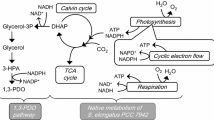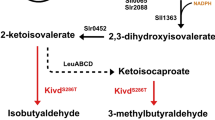Abstract
Synechocystis sp. PCC 6803 is an attractive host for bio-ethanol production due to its ability to directly convert atmospheric carbon dioxide into ethanol using photosystems. To enhance ethanol production in Synechocystis sp. PCC 6803, metabolic engineering was performed based on in silico simulations, using the genome-scale metabolic model. Comprehensive reaction knockout simulations by flux balance analysis predicted that the knockout of NAD(P)H dehydrogenase enhanced ethanol production under photoautotrophic conditions, where ammonium is the nitrogen source. This deletion inhibits the re-oxidation of NAD(P)H, which is generated by ferredoxin-NADP+ reductase and imposes re-oxidation in the ethanol synthesis pathway. The effect of deleting the ndhF1 gene, which encodes NADH dehydrogenase subunit 5, on ethanol production was experimentally evaluated using ethanol-producing strains of Synechocystis sp. PCC 6803. The ethanol titer of the ethanol-producing ∆ndhF1 strain increased by 145%, compared with that of the control strain.




Similar content being viewed by others
References
Deng MD, Coleman JR (1999) Ethanol synthesis by genetic engineering in cyanobacteria. Appl Environ Microbiol 65:523–528
Dexter J, Armshaw P, Sheahan C, Pembroke JT (2015) The state of autotrophic ethanol production in Cyanobacteria. J Appl Microbiol 119:11–24
Gao ZX, Zhao H, Li ZM, Tan XM, Lu XF (2012) Photosynthetic production of ethanol from carbon dioxide in genetically engineered cyanobacteria. Energ. Environ Sci 5:9857–9865
Namakoshi K, Nakajima T, Yoshikawa K, Toya Y, Shimizu H (2016) Combinatorial deletions of glgC and phaCE enhance ethanol production in Synechocystis sp. PCC 6803. J Biotechnol 10:13–19
Choi YN, Park JM (2016) Enhancing biomass and ethanol production by increasing NADPH production in Synechocystis sp. PCC 6803. Bioresour Technol 213:54–57
Chen X, Li S, Liu L (2014) Engineering redox balance through cofactor systems. Trends Biotechnol 32:337–343
Feist AM, Zielinski DC, Orth JD, Schellenberger J, Herrgard MJ, Palsson BO (2010) Model-driven evaluation of the production potential for growth-coupled products of Escherichia coli. Metab Eng 12:173–186
Simeonidis E, Price ND (2015) Genome-scale modeling for metabolic engineering. J Ind Microbiol Biotechnol 42:327–338
Knoop H, Zilliges Y, Lockau W, Steuer R (2010) The metabolic network of Synechocystis sp. PCC 6803: systemic properties of autotrophic growth. Plant Physiol 154:410–422
Montagud A, Navarro E, Fernández de Córdoba P, Urchueguía JF, Patil KR (2010) Reconstruction and analysis of genome-scale metabolic model of a photosynthetic bacterium. BMC Syst Biol 4:156
Yoshikawa K, Kojima Y, Nakajima T, Furusawa C, Hirasawa T, Shimizu H (2011) Reconstruction and verification of a genome-scale metabolic model for Synechocystis sp. PCC 6803. Appl Microbiol Biotechnol 92:347–358
Ogawa T, Harada T, Ozaki H, Sonoike K (2013) Disruption of the ndhF1 gene affects Chl fluorescence through state transition in the Cyanobacterium Synechocystis sp. PCC 6803, resulting in apparent high efficiency of photosynthesis. Plant Cell Physiol 54:1164–1171
Dexter J, Fu P (2009) Metabolic engineering of cyanobacteria for ethanol production. Energy. Environ Sci 2:857–864
Yoshikawa K, Hirasawa T, Shimizu H (2015) Effect of malic enzyme on ethanol production by Synechocystis sp. PCC 6803. J Biosci Bioeng 119:82–84
Angermayr SA, Paszota M, Hellingwerf KJ (2012) Engineering a cyanobacterial cell factory for production of lactic acid. Appl Environ Microbiol 78:7098–7106
Wada K, Toya Y, Banno S, Yoshikawa K, Matsuda F, Shimizu H (2016) 13C-metabolic flux analysis for mevalonate-producing strain of Escherichia coli. J Biosci Bioeng. doi:10.1016/j.jbiosc.2016.08.001
Ohkawa H, Pakrasi HB, Ogawa T (2000) Two types of functionally distinct NAD(P)H dehydrogenases in Synechocystis sp. strain PCC6803. J Biol Chem 275:31630–31634
Ohkawa H, Price GD, Badger MR, Ogawa T (2000) Mutation of ndh genes leads to inhibition of CO2 uptake rather than HCO3 – uptake in Synechocystis sp. strain PCC 6803. J Bacteriol 182:2591–2596
Acknowledgements
We would like to thank Prof. Sonoike (Waseda University) for providing the ΔndhF1 strain of PCC 6803. This work was supported by Grant in Aid for Scientific Research (A) No. 24246134. This work was also supported by JSPS KAKENHI Grant Number 16H06559.
Author information
Authors and Affiliations
Corresponding author
Rights and permissions
About this article
Cite this article
Yoshikawa, K., Toya, Y. & Shimizu, H. Metabolic engineering of Synechocystis sp. PCC 6803 for enhanced ethanol production based on flux balance analysis. Bioprocess Biosyst Eng 40, 791–796 (2017). https://doi.org/10.1007/s00449-017-1744-8
Received:
Accepted:
Published:
Issue Date:
DOI: https://doi.org/10.1007/s00449-017-1744-8




